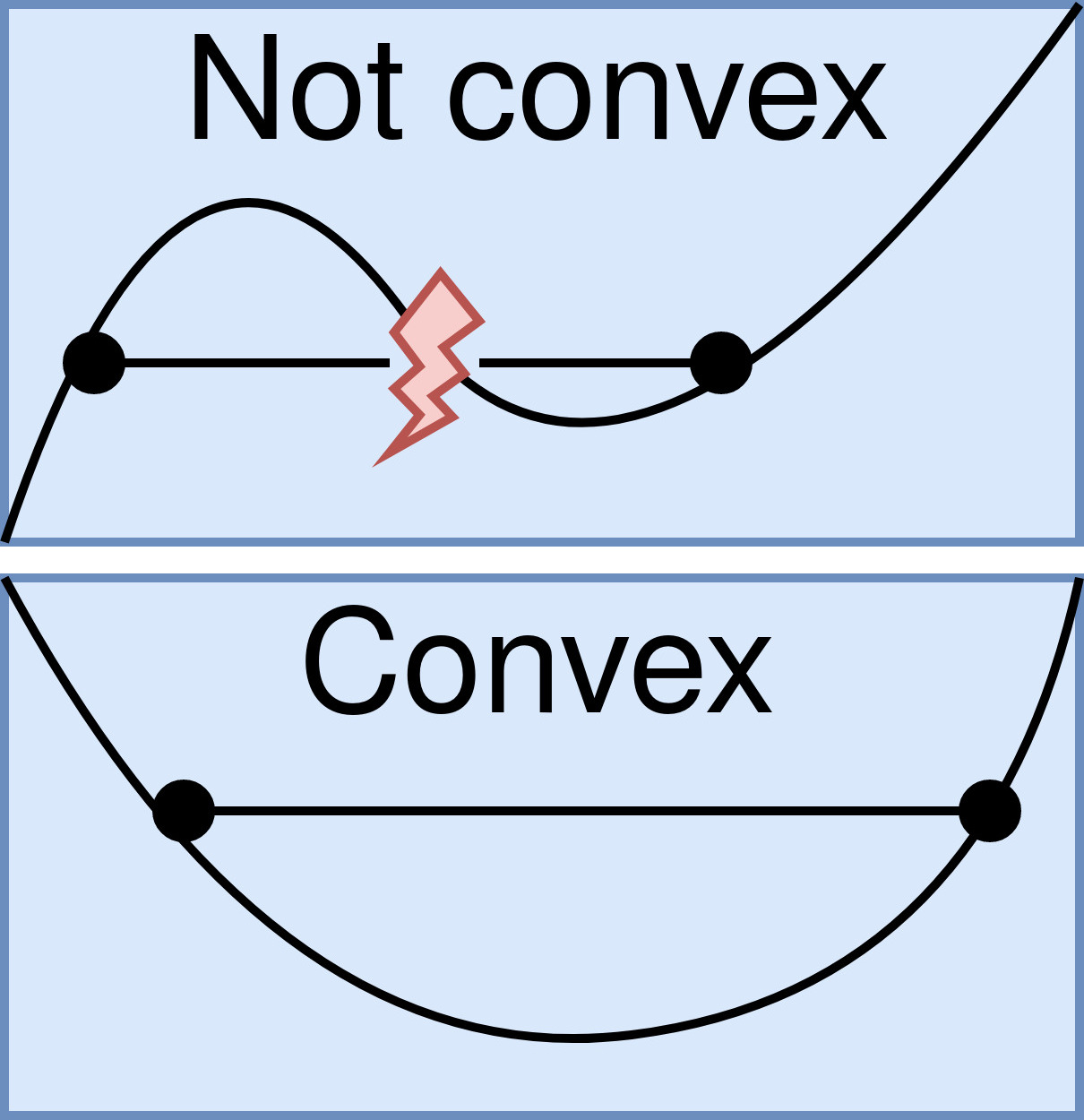|
Minimax Theorem
In the mathematical area of game theory and of convex optimization, a minimax theorem is a theorem that claims that : \max_ \min_ f(x,y) = \min_ \max_f(x,y) under certain conditions on the sets X and Y and on the function f. It is always true that the left-hand side is at most the right-hand side ( max–min inequality) but equality only holds under certain conditions identified by minimax theorems. The first theorem in this sense is von Neumann's minimax theorem about two-player zero-sum games published in 1928, which is considered the starting point of game theory. Von Neumann is quoted as saying "''As far as I can see, there could be no theory of games ... without that theorem ... I thought there was nothing worth publishing until the Minimax Theorem was proved''". Since then, several generalizations and alternative versions of von Neumann's original theorem have appeared in the literature. Bilinear functions and zero-sum games Von Neumann's original theorem was motivated by ... [...More Info...] [...Related Items...] OR: [Wikipedia] [Google] [Baidu] |
Game Theory
Game theory is the study of mathematical models of strategic interactions. It has applications in many fields of social science, and is used extensively in economics, logic, systems science and computer science. Initially, game theory addressed two-person zero-sum games, in which a participant's gains or losses are exactly balanced by the losses and gains of the other participant. In the 1950s, it was extended to the study of non zero-sum games, and was eventually applied to a wide range of Human behavior, behavioral relations. It is now an umbrella term for the science of rational Decision-making, decision making in humans, animals, and computers. Modern game theory began with the idea of mixed-strategy equilibria in two-person zero-sum games and its proof by John von Neumann. Von Neumann's original proof used the Brouwer fixed-point theorem on continuous mappings into compact convex sets, which became a standard method in game theory and mathematical economics. His paper was f ... [...More Info...] [...Related Items...] OR: [Wikipedia] [Google] [Baidu] |
Convex Function
In mathematics, a real-valued function is called convex if the line segment between any two distinct points on the graph of a function, graph of the function lies above or on the graph between the two points. Equivalently, a function is convex if its epigraph (mathematics), ''epigraph'' (the set of points on or above the graph of the function) is a convex set. In simple terms, a convex function graph is shaped like a cup \cup (or a straight line like a linear function), while a concave function's graph is shaped like a cap \cap. A twice-differentiable function, differentiable function of a single variable is convex if and only if its second derivative is nonnegative on its entire domain of a function, domain. Well-known examples of convex functions of a single variable include a linear function f(x) = cx (where c is a real number), a quadratic function cx^2 (c as a nonnegative real number) and an exponential function ce^x (c as a nonnegative real number). Convex functions pl ... [...More Info...] [...Related Items...] OR: [Wikipedia] [Google] [Baidu] |
Game Theory
Game theory is the study of mathematical models of strategic interactions. It has applications in many fields of social science, and is used extensively in economics, logic, systems science and computer science. Initially, game theory addressed two-person zero-sum games, in which a participant's gains or losses are exactly balanced by the losses and gains of the other participant. In the 1950s, it was extended to the study of non zero-sum games, and was eventually applied to a wide range of Human behavior, behavioral relations. It is now an umbrella term for the science of rational Decision-making, decision making in humans, animals, and computers. Modern game theory began with the idea of mixed-strategy equilibria in two-person zero-sum games and its proof by John von Neumann. Von Neumann's original proof used the Brouwer fixed-point theorem on continuous mappings into compact convex sets, which became a standard method in game theory and mathematical economics. His paper was f ... [...More Info...] [...Related Items...] OR: [Wikipedia] [Google] [Baidu] |
Yao's Principle
In computational complexity theory, Yao's principle (also called Yao's minimax principle or Yao's lemma) relates the performance of randomized algorithms to deterministic (non-random) algorithms. It states that, for certain classes of algorithms, and certain measures of the performance of the algorithms, the following two quantities are equal: *The optimal performance that can be obtained by a deterministic algorithm on a random input (its average-case complexity), for a probability distribution on inputs chosen to be as hard as possible and for an algorithm chosen to work as well as possible against that distribution *The optimal performance that can be obtained by a random algorithm on a deterministic input (its expected complexity), for an algorithm chosen to have the best performance on its worst case inputs, and the worst case input to the algorithm Yao's principle is often used to prove limitations on the performance of randomized algorithms, by finding a probability distrib ... [...More Info...] [...Related Items...] OR: [Wikipedia] [Google] [Baidu] |
Dual Linear Program
The dual of a given linear program (LP) is another LP that is derived from the original (the primal) LP in the following schematic way: * Each variable in the primal LP becomes a constraint in the dual LP; * Each constraint in the primal LP becomes a variable in the dual LP; * The objective direction is inversed – maximum in the primal becomes minimum in the dual and vice versa. The weak duality theorem states that the objective value of the dual LP at any feasible solution is always a bound on the objective of the primal LP at any feasible solution (upper or lower bound, depending on whether it is a maximization or minimization problem). In fact, this bounding property holds for the optimal values of the dual and primal LPs. The strong duality theorem states that, moreover, if the primal has an optimal solution then the dual has an optimal solution too, ''and the two optima are equal''. Pages 81–104. These theorems belong to a larger class of duality theorems in optimizat ... [...More Info...] [...Related Items...] OR: [Wikipedia] [Google] [Baidu] |
Parthasarathy's Theorem
In mathematics – and in particular the study of games on the unit square – Parthasarathy's theorem is a generalization of Von Neumann's minimax theorem. It states that a particular class of games has a mixed value, provided that at least one of the players has a strategy that is restricted to absolutely continuous distributions with respect to the Lebesgue measure (in other words, one of the players is forbidden to use a pure strategy). The theorem is attributed to Thiruvenkatachari Parthasarathy. Theorem Let X and Y stand for the unit interval ,1/math>; \mathcal M_X denote the set of probability distributions on X (with \mathcal M_Y defined similarly); and A_X denote the set of absolutely continuous distributions on X (with A_Y defined similarly). Suppose that k(x,y) is bounded on the unit square X \times Y = \ and that k(x,y) is continuous except possibly on a finite number of curves of the form y=\phi_k(x) (with k=1,2,\ldots,n) where the \phi_k(x) are continuous funct ... [...More Info...] [...Related Items...] OR: [Wikipedia] [Google] [Baidu] |
Quasi-convex Function
In mathematics, a quasiconvex function is a real-valued function defined on an interval or on a convex subset of a real vector space such that the inverse image of any set of the form (-\infty,a) is a convex set. For a function of a single variable, along any stretch of the curve the highest point is one of the endpoints. The negative of a quasiconvex function is said to be quasiconcave. Quasiconvexity is a more general property than convexity in that all convex functions are also quasiconvex, but not all quasiconvex functions are convex. ''Univariate'' unimodal functions are quasiconvex or quasiconcave, however this is not necessarily the case for functions with multiple arguments. For example, the 2-dimensional Rosenbrock function is unimodal but not quasiconvex and functions with star-convex sublevel sets can be unimodal without being quasiconvex. Definition and properties A function f:S \to \mathbb defined on a convex subset S of a real vector space is quasiconvex if ... [...More Info...] [...Related Items...] OR: [Wikipedia] [Google] [Baidu] |
Upper Semicontinuous
In mathematical analysis, semicontinuity (or semi-continuity) is a property of extended real-valued functions that is weaker than continuity. An extended real-valued function f is upper (respectively, lower) semicontinuous at a point x_0 if, roughly speaking, the function values for arguments near x_0 are not much higher (respectively, lower) than f\left(x_0\right). Briefly, a function on a domain X is lower semi-continuous if its epigraph \ is closed in X\times\R, and upper semi-continuous if -f is lower semi-continuous. A function is continuous if and only if it is both upper and lower semicontinuous. If we take a continuous function and increase its value at a certain point x_0 to f\left(x_0\right) + c for some c>0, then the result is upper semicontinuous; if we decrease its value to f\left(x_0\right) - c then the result is lower semicontinuous. The notion of upper and lower semicontinuous function was first introduced and studied by René Baire in his thesis in 1899. ... [...More Info...] [...Related Items...] OR: [Wikipedia] [Google] [Baidu] |
Function (mathematics)
In mathematics, a function from a set (mathematics), set to a set assigns to each element of exactly one element of .; the words ''map'', ''mapping'', ''transformation'', ''correspondence'', and ''operator'' are sometimes used synonymously. The set is called the Domain of a function, domain of the function and the set is called the codomain of the function. Functions were originally the idealization of how a varying quantity depends on another quantity. For example, the position of a planet is a ''function'' of time. History of the function concept, Historically, the concept was elaborated with the infinitesimal calculus at the end of the 17th century, and, until the 19th century, the functions that were considered were differentiable function, differentiable (that is, they had a high degree of regularity). The concept of a function was formalized at the end of the 19th century in terms of set theory, and this greatly increased the possible applications of the concept. A f ... [...More Info...] [...Related Items...] OR: [Wikipedia] [Google] [Baidu] |
Linear Topological Space
In mathematics, a topological vector space (also called a linear topological space and commonly abbreviated TVS or t.v.s.) is one of the basic structures investigated in functional analysis. A topological vector space is a vector space that is also a topological space with the property that the vector space operations (vector addition and scalar multiplication) are also continuous functions. Such a topology is called a and every topological vector space has a uniform topological structure, allowing a notion of uniform convergence and completeness. Some authors also require that the space is a Hausdorff space (although this article does not). One of the most widely studied categories of TVSs are locally convex topological vector spaces. This article focuses on TVSs that are not necessarily locally convex. Other well-known examples of TVSs include Banach spaces, Hilbert spaces and Sobolev spaces. Many topological vector spaces are spaces of functions, or linear operators acting on ... [...More Info...] [...Related Items...] OR: [Wikipedia] [Google] [Baidu] |
Kodai Mathematical Journal
Kodai or Kōdai may refer to: * Kōdai (given name), a masculine Japanese given name *Kōdai or Takadai, a frame used for making kumihimo, a type of Japanese braid *Kodaikanal Kodaikanal () (English: ) is a municipality and hill station in Dindigul district in the state of Tamil Nadu, India. It is situated at an altitude of in the Palani hills of the Western Ghats. Kodaikanal was established in 1845 to serve as a r ..., a hill station located in Dindigul district in the state of Tamil Nadu, India *'' Kodai'' (2023), Indian Tamil-language film directed by Raajaselvam {{disambiguation ... [...More Info...] [...Related Items...] OR: [Wikipedia] [Google] [Baidu] |
Pacific Journal Of Mathematics
The Pacific Journal of Mathematics is a mathematics research journal supported by several universities and research institutes, and currently published on their behalf by Mathematical Sciences Publishers, a non-profit academic publishing organisation, and the University of California, Berkeley. It was founded in 1951 by František Wolf and Edwin F. Beckenbach and has been published continuously since, with five two-issue volumes per year and 12 issues per year. Full-text PDF versions of all journal articles are available on-line via the journal's website with a subscription. The journal is incorporated as a 501(c)(3) organization A 501(c)(3) organization is a United States corporation, Trust (business), trust, unincorporated association or other type of organization exempt from federal income tax under section 501(c)(3) of Title 26 of the United States Code. It is one of .... The 255-page proof of the odd order theorem, by Walter Feit and John Griggs Thompson, was publi ... [...More Info...] [...Related Items...] OR: [Wikipedia] [Google] [Baidu] |


